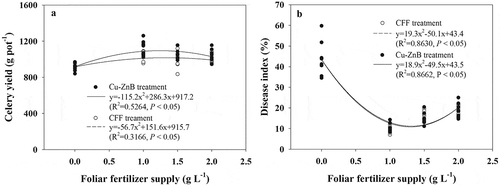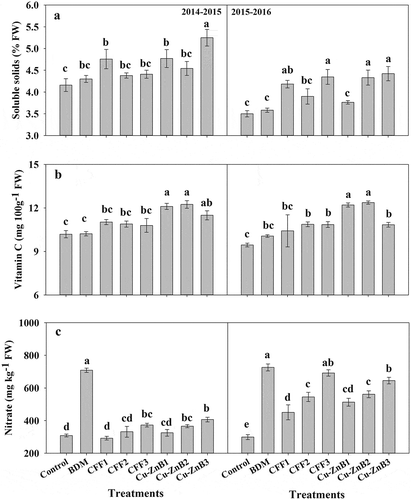Figures & data
Table 1. Celery yield and dry weight. Data shown are means of the two growing seasons.
Table 2. Disease index for celery. Data shown are means of the two growing seasons.
Figure 1. Copper foliar fertilizer concentration and celery yield and disease index during two growing seasons (n = 32).

Table 3. Celery plant height and stem diameter in 2015–2016.
Figure 2. Content of soluble compounds from celery leaves in each growing season including solid solids (a), vitamin C (b), and nitrate (c).
Note: Date are mean ± standard deviations (SD) (n = 4). Means within each graph for a soluble compound and season followed by the same letter were not significantly different based on a one-way ANOVAs followed with Duncan’s multiple range tests (P > 0.05). Control (pure water); BDM (Bordeaux mixture); CFF1, CFF2, and CFF3 (1.0, 1.5, and 2.0 g L−1 copper-based foliar fertilizer, respectively); Cu-ZnB1, Cu-ZnB2, and Cu-ZnB3 (1.0, 1.5, and 2.0 g L−1 copper-based-zinc-boron foliar fertilizer, respectively).

Table 4. Antioxidant enzyme activities and MDA content of celery functional leaves in 2015–2016.
Figure 3. Contact angles between droplets of different applied foliar fertilizer treatments and celery leaves: a. control (pure water); b. BDM (Bordeaux mixture); c. CFF1 (1.0 g L−1 copper-based foliar fertilizer); d. Cu-ZnB1 (1.0 g L−1 copper-based-zinc-boron foliar fertilizer).

Table 5. Microelement concentrations of stems and leaves. Data shown are means of the two growing seasons.
Table 6. Correlation analyses of leaf microelement concentrations, disease index, quality, and yield for celery at harvest (n = 80). Data shown are means of the two growing seasons.
Table 7. Soil pH and available microelement concentrations in 2014–2015 and 2015–2016.
